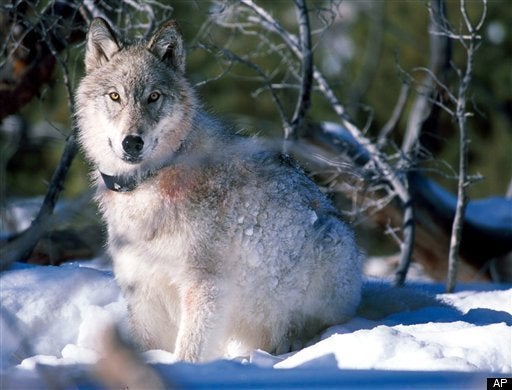
In the cold, dawn light of Yellowstone's Lamar Valley, I watched the Crystal Creek wolf pack at play. It was 1995, and these were the first wolves to return to Yellowstone in 60 years. Fifteen years ago, we had no idea of how successful and popular wolf reintroduction would be. Or how wolves would revitalize this damaged ecosystem -- astonishingly increasing the health of everything from trees to songbird populations.
That morning, the vast, panoramic meadow below was abloom with spring wildflowers as the Crystal Creek alpha male and female loped across the green meadows, followed by their rambunctious pups.
"This is history in the making," said Park ranger and wolf researcher Rick McIntyre, as he let us take turns watching the wolf pack through his spotting telescope. "Our children will thank us for this."
McIntyre, author of The War Against the Wolf: America's Campaign to Exterminate the Wolf, had no way of knowing then that from these few small bands of wolves returned to Yellowstone in 1995, there would now be 1,650 in the Northern Rockies. But this still is far from original pre-hunting numbers; and only five percent of their former range.
"Look!" he pointed excitedly. "Over on the far ridge . . . do you see the grizzly?"
Even from half a mile away, we all held our breath as we watched the grizzly rise up on her hind legs, nose raised to catch the scent of canine lupus.
"There's a kind of professional courtesy between top predators, like wolves and grizzlies," McIntyre whispered to us. "The grizzlies know the wolves are back. You can see they're completely aware of each other." Ranger McIntyre laughed softly. "But you know, these top predators can share."
Unlike us, it seems.
Recently, more than 500 wild wolves have been gunned down after the Obama administration denied them federal protection in Montana and Idaho. More hunts were on target for this fall across the northern Rockies. Wolf control plans included proposals to slaughter entire packs and gas newborn pups in their den.
A successful lawsuit by NRDC and Earthjustice stopped the hunts -- temporarily. Now that far-sighted legislation, like the wolves, is under threat.
The next weeks are vital for wolves to survive a new bill that would again declare open season on wolves. Senators Baucus and Tester of Montana have just introduced legislation that would by-pass current law and again strip the wolves of endangered species protection. This Baucus-Tester bill will be voted upon -- without public hearings or comment -- in the next two weeks.
How many times do we have to fight this same old battle until public policy at last mirrors public opinion? And 21st century science? A recent National Wildlife Federation poll revealed that 63 percent of Americans opposed removing wolves from Yellowstone and central Idaho. Because of successful wolf introduction, tourism and ecosystems have flourished.
In the past fifteen years of studying wolves returned to their native habitat, scientists have discovered that these top predators actually help balance and restore the entire ecosystem. Duke University researchers have documented that predators keep the world green because they keep plant-eating animals, such as deer and elk, under control. Then native plants can thrive, free from overgrazing. U.S. scientist Nelson Hairston, among others, first theorized this "green world hypothesis" in 1960. Now, other researchers are proving this theory true -- especially in Yellowstone.
One of those scientists, author and conservation biologist Cristina Eistenberg of Oregon State University is part of the vanguard of researchers documenting why wolves matter so much to our healthy ecosystems. A Boone and Crockett fellow, Eisenberg's book The Wolf's Tooth: Keystone Predators, Trophic Cascades, and Biodiversity, has revolutionized the way we see wolves.
"Wolves nurture the entire ecosystem," Eisenberg explains. "If we eradicate wolves or lower their numbers, the whole system will grow impoverished and collapse."
Her research documents recovery of over-grazed aspen, willows, and cottonwoods. Stream banks are less eroded and there is a dramatic increase of biodiversity of songbirds. In the decades when our government was savagely wiping out almost all wolves from our wild lands, who knew that we were also destroying the vital keystone of those ecosystem -- the top predators?
Returning to past devastating environmental policies of wolf hunts is not wildlife management. It is ignorance born of decades of fear and prejudice. In the 21st century, hunters and ranchers must no longer solely manage wildlife. We desperately need new science and sustainable policies to restore our healthy habitats.
Wild wolves in the northern Rockies should be protected. Until science -- not politics -- proves that the species has fully recovered. Why not let other top predators once again do their natural part in restoring our wild lands? Why not let wolves help us keep our world green?
Brenda Peterson is a National Geographic author. Her many books include Build Me an Ark: A Life with Animals, in which she profiled the first wolf reintroduction in Yellowstone and wolf control in Alaska.
For more: www.IWanttoBeLeftBehind.com
To help stop the hunts and contact your senators:
"Wolf Wars," National Geographic:
http://ngm.nationalgeographic.com/2010/03/wolf-wars/chadwick-text
